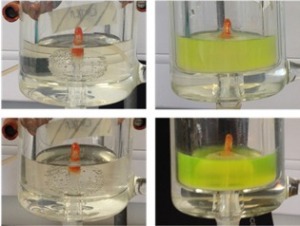by
Christina Hwang, Contributing Reporter | April 27, 2016

Will turn urine a bright yellow
color if bacteria is detected
Courtesy: Dr. Jenkins
A new infection alert system that changes the color of urine in the presence of Proteus mirabilis, the most common cause of catheter blockage, has been developed by researchers in the UK.
The system, designed by Dr. Toby Jenkins and his colleagues at the University of Bath, is made of two coatings and was tested with a glass bladder, artificial urine, and bacteria from patient samples.
“The bottom layer, on the catheter, is a hydrogel of poly vinyl alcohol and water, which is our dye reservoir, and the top layer is Eurdagit, a pH-sensitive polymer used in drug coatings for enteric delivery,” Jenkins told HCB News.




Ad Statistics
Times Displayed: 29537
Times Visited: 722 Stay up to date with the latest training to fix, troubleshoot, and maintain your critical care devices. GE HealthCare offers multiple training formats to empower teams and expand knowledge, saving you time and money
The Eurdagit reacts to pH changes in the urine caused by the bacteria, and as the urine becomes more alkaline, dissolves the top layer, releasing the bright yellow dye, the color that signals infection. When there was no bacterial infection, the dye in the second layer was not affected despite liquid constantly flowing past it.
Over time, bacteria can develop inside the catheter tube, eventually leading to blockage. And when the urine is pushed back into the kidneys, can cause kidney failure, whole-body infection and death.
“It’s a triggered release architecture that can be used for early diagnosis of infection but also is proof of principle for using the same system for delivery of antimicrobials to treat infection in-situ when and where required,” said Jenkins.
Approximately 100 million urinary catheters are used around the world every year, and the infections they can bring cause problems for thousands of people, according to the announcement. Biofilms built by the bacteria are not easy to treat since they cannot be broken down by antibiotics.
The researchers plan on testing the coating using urine collected from volunteers and then running a clinical trial showing the benefits and safety it could bring to patients.
"Catheter-related infections are a serious problem, especially if the bacteria are resistant to antibiotics. We hope that with this simple-to-use sensor system we can ultimately make a real difference to patients' lives," said Jenkins, in a statement.
The cost of treating urinary infection is estimated to be around £120 million annually in England and Wales, and according to the CDC, hospital-acquired urinary infections affect more than 90,000 patients a year in the U.S.

